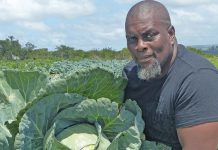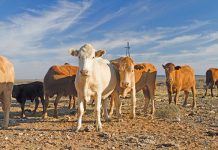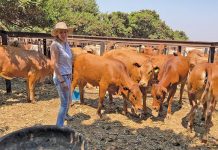
Owner of the well-known Op die Aarde Bonsmara stud, Frans van den Berg has been looking for an effective veld management system for years. “I started farming in 1962 and tried various ways to improve the veld quality to increase profitability,” he recalls. “My management decisions had to be profit-driven instead of production-driven, and I considered veld management a major factor in profitability.“The cattle on the land and the condition of the veld are the two primary pillars in cattle farming in extensive areas such as ours. Over the years I could achieve the breeding objectives I aimed for, but found it difficult to make the most of grazing to increase profitability.
“That was until I came across the Controlled Fodder Flow Pasture Management Strategy (CFFPMS) as developed by Riaan Dames, a rangeland scientist at the agriculture department.”Frans farms on 10 403ha and currently runs 1 493 mature livestock units (MLU) – according to the well-known Meissner conversion tables – on his land. That’s 35% above the departmental carrying capacity norm for the area and 45% more than before he implemented the CFFPMS. “The basic principle is that a veld management system or strategy must enhance the animals’ performance and production,” he explains.
“There is a fine balance in pushing up profitability without harming the business. For instance, I can cut down on inputs such as licks, but not to the detriment of the animals. CFFPMS is an uncomplicated system that yields relatively rapid results, such as an increased stocking rate.
“The genetic improvement of a herd can take years, but we have proven over the past eight years that proper veld management can increase profit considerably in a short time.”
Soil quality
The CFFPMS markedly improved veld condition as well as soil quality. “We inherited degraded veld to begin with,” says Frans. “Rangelands in our district were seriously damaged during the first half of last century. Dairy farmers produced milk on a large scale for a cheese factory in Reivilo, and the continuous movement of animals between veld and milking parlours, among other things, caused untold damage.
Large numbers of cows kept on relatively small farms caused large scale land degradation. “But, through yearlong resting and controlled grazing practices, we’ve managed to turn the situation around, as you see from the increased stocking rate. Climax grass species, including Themeda triandra, have increased tremendously, even though we saw very little if any change in the species composition during the previous 40 years.”
The grazing land is divided in 96 camps of around 100ha each. Frans never stocks more than 100 animals per camp. The CFFPMS allows at least 50% of all grazing land to rest for a year (from August to July the following year). This is crucial for the veld to recover vigour and ensures maximum root growth for optimium grass production during the growing season. Every herd has at least two camps at its disposal. Op die Aarde uses a system of camps that are grazed and rested alternatively.
“During the two relatively short breeding seasons we run one breeding herd with a bull and around 34 females per camp and afterwards two breeding herds (75 animals) per camp,” Frans continues. “We never use high intensity grazing, and even with young animals we never run more than 100 animals per camp. “Resting camps with long grass are next to grazing camps with shorter grass to prevent any veld fires from spreading. The CFFGMS provides for controlled burning to manage bush encroachment and as a competition equaliser once every 10 to 15 years.
“Research from other parts of the world shows that fire increases plant-available phosphorous in the soil. Burning is a tool for a specific purpose, not a routine part of the strategy.” Nevertheless, Riaan recommends that the need for and use of fire should be evaluated independently by experts.
Rapid Rotation.
The duration of a grazing period varies according to the season. “Avoid huge fluctuations in the nutritional level of the grazing camps,” Riaan advises. “Never graze a camp down to the ground and start with a long grown-out camp every time you move animals. Rather rotate more rapidly between camps to allow one to two months’ rest during the growing season. The short resting periods let the veld recover enough for a second grazing period and to keep it in good condition in the long term.
“However, the grass should not set seed during the resting periods, since the nutritional levels of grass decline from spring to seeding stage. During the end of the growing season we want 80% of the grass in the grazing camps utilised before the resting period starts.”
The basal cover has improved significantly since implementing CFFPMS on Op die Aarde. This limits water evaporation, crucially important in semi-arid areas. “Again, this markedly increased Op die Aarde’s stocking rate,” Frans explains. “Heavy grazing before the start of the resting period prevents a mass of moribund grass at the end of it. It also causes grass roots to die back, supplying an excellent source of organic matter to the soil. Increased organic matter enhances the soil’s water-holding capacity. “A long resting period also results in good grass cover in areas usually left bare by the intensive trampling of cattle, like under trees and bushes and around water and lick points. Added together, these areas contribute significantly to the total grazing.”
He adds that the strategy has also interrupted the life cycles of ticks and other parasites, dramatically reducing parasite loads as well as the need to dip and dose, and resulting in a marked increase in dung beetles. Riaan agrees, adding that almost all farmers following CFFPMS stop dipping and even spot treatment for parasites after five to 10 years. Contact Frans van den Berg on 082 944 0734 and Riaan Dames on 084 273 8666. |fw













